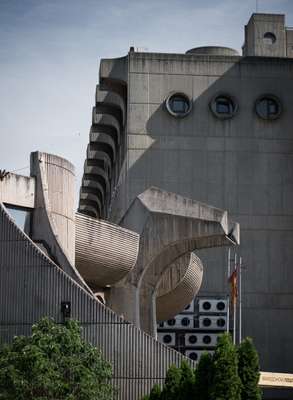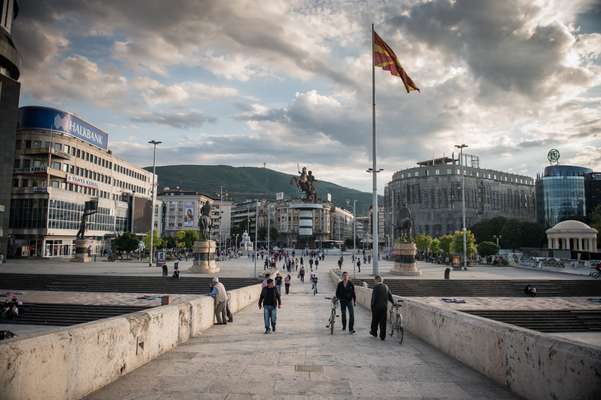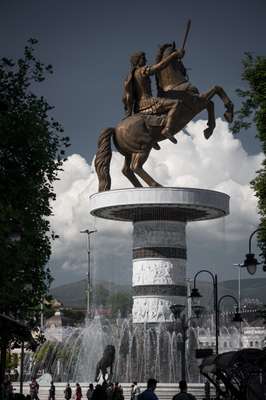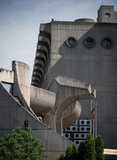Skopje 2014 / Skopje
Start again
A plethora of new statues, museums and government buildings is appearing across the Republic of Macedonia’s capital in a bid to imbue it with a sense of civic pride – but not everyone is persuaded by the less than subtle approach.
For a man who says his English is rusty, Miroslav Grcev has a well-oiled line in razor-sharp epithets. And when the architect, professor of urban design and originator of the current Macedonian flag gets going, woe betide the object of his ire.
“In architecture and urban design, this is crime against public space, culture, urbanism and art; against the city and the citizen,” he says. The alleged crime in question is the project known as Skopje 2014: not so much a redesign of the city as an effort to recast Macedonia’s capital as the cradle of civilisation.
The project, instigated by prime minister Nikola Gruevski, clicked into gear four years ago and has proceeded at breathtaking speed since then. The banks of the Vardar river, which runs through the city centre, now boast new museums, government buildings and a reconstructed national theatre. All of them have been built in a style its proponents label either neo-classical or baroque, in striking contrast to the modernist character of most of Skopje.
Then there are the statues. Countless dozens of bronze-cast figures have sprouted up seemingly everywhere. Just on the newly constructed Art bridge across the Vardar there are no fewer than 29 of them, representing significant Macedonian figures in music, literature and visual arts. Elsewhere in the city, everyone from Emperor Justinian to Mother Teresa has a monument by way of a reminder that this small country has produced great people.





But the piece de resistance is in Macedonia square. A gigantic representation of a warrior on a horse now dominates this previously empty plaza. The figure – which may or may not be Alexander the Great, depending on who you ask – perches on top of a thick column, surrounded by lions. Music, lights and dancing fountains provide the icing on the cake.
The transformation is certainly not to everyone’s taste. “I stopped going to the centre of the city,” says Grcev. “When I have to go past those monstrous, criminal colonnades and things which are not sculpture, I walk with my head down and my eyes to my shoes – the walk of a dead man.”
The creator of the most contentious of the statues shrugs at the fuss her work has created. Business is brisk for sculptor Valentina Stefanovska at her workshop in a suburb of Skopje. Before she won the competition to construct the centrepiece of Skopje 2014 she had barely had a professional commission. Now she’s made her mark on the city with the Arc de Triomphe-inspired Porta Macedonia that stands within sight of the aforementioned rampant warrior.
“The centre of the city was a little bit empty before,” says Stefanovska. “There was too much space. People might have been against the statues but now they congratulate me.”
Skopje is no stranger to radical change. In 1963, an earthquake flattened four-fifths of the city and forced a total rebuild, overseen by Kenzo Tange, the Japanese architect and urban planner who had performed a similar duty in post-war Hiroshima. Now some of the constructions from that era are suffering the ultimate architectural indignity: remodelling in the style of the Skopje 2014 project. Baroque frontages have already been added to the previously clean-cut lines of the commercial and residential buildings around Macedonia square.
The most dramatic makeover has still to be completed. Awnings draped over the glass and concrete cubes of government house depict its fate: neo-classical columns and curves.
These alterations have driven many Macedonian architects to distraction and other residents of Skopje have also voiced their objections – or, in the case of Ivana Dragsic, sung them. The radio presenter formed the Singing Skopjans as a way of protesting without running the risk of receiving a beating, as happened when demonstrators first criticised Skopje 2014. Now Dragsic and her colleagues make their points with flash-mob musical performances around the city, which they also film for distribution via social media.
Walking round the concrete lotus-flower of the central post office, Dragsic says the city is losing part of its character. “What excites me about these Tange-era buildings are the spaces they provide. All of the little corners and hallways have a role – they provide a lot of sociability, an opportunity to connect with yourself and with others.”
But there are those who insist that Skopje 2014 is providing precisely the identity that was previously lacking. The current head of the foreign-affairs committee – and former foreign minister – Antonio Milososki points to the jump in tourist arrivals as proof of the project’s success in raising the city’s profile. And he says that, for once, the changes have been locally driven.
“In different periods of history our neighbours or empires decided on the structure, constitution and city architecture whether they were Ottomans, Serbs, Bulgarians or other bigger states,” says Milososki. “Now, for the first time since independence, we have put our stamp on our capital city.” At least that is one point that is beyond debate.


